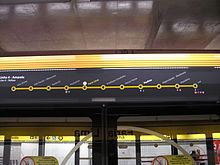Stations 11 Opened May 25, 2010 Terminis Paulista, Butantã | Website www.metro.sp.gov.br Locale São Paulo | |
 | ||
Status Partially in operation,partially in construction,partially in planning | ||
Line 4 (Yellow) (Portuguese: Linha 4-Amarela) is a line of the São Paulo Metro, originally called Southeast-Southwest Line. When finished, it will go from Luz to Vila Sônia. The first stretch, between and Faria Lima and Paulista stations, opened on May 25, 2010. Two other stations, Butantã and Pinheiros, were opened in July 2011. Today, the line goes from Butantã to Luz. It is expected that the line will be fully completed by 2015. It is operated by ViaQuatro, a private company which won the public-private partnership to operate Line 4 for 30 years, which can be renewable for another 30 years. Companhia do Metropolitano de São Paulo monitors the operation.
Contents
Conception
Conceived since the years 1940s, the route of Line 4-Yellow was present in all studies for deployment of the Metro in São Paulo since. This road was consolidated in 1968 when the initial studies for the implementation of the current subway network, receiving at that time, the name of Southeast-Southwest Line. In parable form, would connect the neighborhoods of Pinheiros and Sacomã, from Jóquei Clube station to Via Anchieta station, through the Downtown, cutting East-West line of the Metro in República and Pedro II stations. Integration platforms came to be built in those two stations, but were not used. The Republic station platforms, built in the 1980s, with a further configuration of line 4, would be demolished for the passage of the tunneling machine, equipment that built the tunnel of Line 4 between Faria Lima and Luz stations, those from Pedro II station became a depôt. The consolidation of the project was only in 1993, when the basic design was first developed, already no longer including the Southeast portion, embedded in other policies of the Metro expansion and improvement of commuter trains.
Even in the 1990s, the Metro considered taking Line 4 to Tatuapé station, with the intent to relieve the Line 3-Red. This idea was discarded, having been replaced by a possible expansion of the Line 2-Green until that section. The construction of the Expresso Tiradentes (formerly Fura-Fila), designed in the administration of mayor Celso Pitta and the first section delivered in 2007, further reinforced the intention to build Line 4 only in the vector southwest of the city, from Luz Station.
Construction
Construction was carried out in several phases, with trains initially operating from Luz to Butantã in Phase 1 with six stations, followed by five more stations and the full run from Luz to Vila Sônia in Phase 2.
On January 12, 2007, during the construction of Pinheiros station, a large part of the site's access tunnel collapsed, opening an 80 m (265 ft) diameter crater, killing seven people. Several houses and vehicles were swallowed by the hole, including a minibus; four of the victims were inside. A lot more houses suffered heavy damage, with several of these being declared condemned. Following Pinheiros' accident, Época magazine, aside Rede Globo, made a series of revelations about the security of the other line's stations, then still in building stage, dispensing special attention to the Paulista station, at Consolação quarter, a more heavily populated area, where a crater like that would have claimed a lot more lives. The line's works were kept paralysed for about two months. Because of the press' accusations, the timetable was delayed for about four months, and Pinheiros construction could only be resumed after the end of the analysis procedures designed to discover the accident's cause. The reports were delivered in August, 2008, representing a delay of almost two years on the station's works. After work on the line resumed, two teams were digging the tunnel (one from each end, planning to meet in the middle).
As the two tunnels ("Caxingui" and "Três Poderes") approached their meeting point, a horizontal error of 80 cm (2.6 ft) between the two was discovered. The error was reported on 12 September 2007, and was caused by an error in topography. ViaQuatro said that there would be no delay or cost overruns due to this error.
During April, 2010, at the site of São Paulo: Morumbi station, a 30 m (100 ft) crane fell while hoisting building material from the bottom of the site. The crane fell across the pavement of Ave Prof. Francisco Morato; there were no injuries and work was not interrupted.
In 2009 the Brazilian Federal Police opened an investigation into Camargo Corrêa enterprises about 14 of their construction works, including Line 4, as part of Operação Castelo de Areia ("Operation Sand Castle") looking into potential bribes paid to politicians.
Opening
The line opened in 2010. The line was privately funded by ViaQuatro, who will own and operate the line and receive the profits from it for 20 years, after which it will be transferred to the state.
Expansion
A proposed extension is planned from Luz to Isolina Mazzei. Another extension is planned from Vila Sonia to Embu Das Artes.
Technical specification
The line uses standard gauge with a width of 1435mm, and an overhead catenary power supply. All stations have platform screen doors. The trains use communications-based train control driverless technology, can operate with a distance of one car between trains if need be, and do not have cabs.
